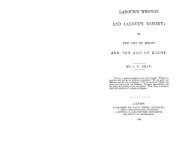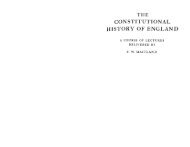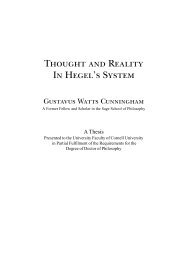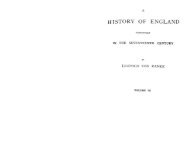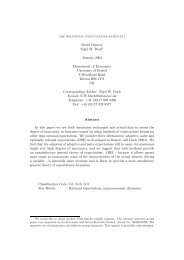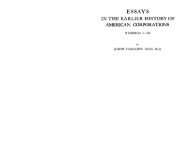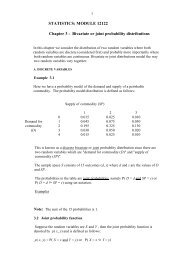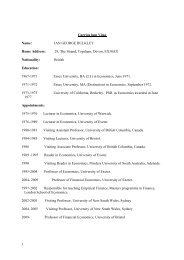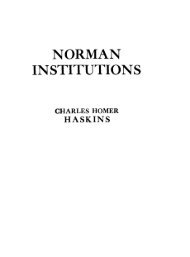64 AGRICULTUREtime was well spent in spinning for the family.The flax or hemp grown on the allotment, wasstored up for shirts and house-linen. If the husbandmanhad no sheep, the children gathered scraps <strong>of</strong>wool from the brambles on the common, and thusthe only money cost <strong>of</strong> the stuff worn by thehusbandman's househ~ld was the price paid to theweaver.The more prosperous the family, the less the motherwent outside to work, but this did not mean, as undermodern conditions, that her share in the productive<strong>life</strong> <strong>of</strong> the country was less. Her productive energyremained as great, but was directed into channelsfrom which her family gained the whole pr<strong>of</strong>it. Inher humble way she fed and clothed them, like thewise woman described by Solomon.The more she was obliged to work for wages, thepoorer was her family.C. Wage-earners.In some respects it is less difficult to visualise thelives <strong>of</strong> <strong>women</strong> in the wage-earning class than in theclass <strong>of</strong> farmers and husbandmen. The narrowness<strong>of</strong> their circumstances and the fact that their destitutionbrought them continually under the notice<strong>of</strong> the magistrates at Quarter Sessions have preserveddata in greater completeness from which to reconstructthe picture. Had this information been wantingsuch a reconstruction would have demanded no vividimagination, because the results <strong>of</strong> the semistarvation<strong>of</strong> mothers and small children are verysimilar whether it takes place in the <strong>seventeenth</strong> orthe twentieth <strong>century</strong> ; the circumstances <strong>of</strong> thewives <strong>of</strong> casual labourers and men who are out <strong>of</strong> workand " unemployable " in modern England maybe taken as representing those <strong>of</strong> almost the wholewage-earning class in the <strong>seventeenth</strong> <strong>century</strong>.The most important factors governing the lives <strong>of</strong>wage-earning <strong>women</strong> admit <strong>of</strong> no dispute. FirstAGRICULTUREamong these was their income, for wage-earners havealready been defined as the class <strong>of</strong> persons dependingwholly upon wages for the support <strong>of</strong> theirfamilies.Throughout the greater part <strong>of</strong> the <strong>seventeenth</strong><strong>century</strong> the rate <strong>of</strong> wages was not left to be adjustedby the laws <strong>of</strong> supply and demand, but was regulatedfor each locality by the magistrates at Quarter Sessions.Assessments fixing the maximum rates were publishedannually and were supposed to vary according to theprice <strong>of</strong> corn. Certainly they did vary from districtto district according to the price <strong>of</strong> corn in thatdistrict, but they were not <strong>of</strong>ten changed from year toyear.Prosecutions <strong>of</strong> persons for <strong>of</strong>fering and receivingwages in excess <strong>of</strong> the maximum rates frequentlyoccurred in the North Riding <strong>of</strong> Yorkshire, but it isextremely rare to find a presentment for this in otherQuarter Sessions. The Assessments were generallyaccepted as publishing a rate that public opinionconsidered fair towards master and man, and outsideYorkshire steps were seldom taken to prevent mastersfrom paying more to valued serl-ants. That upon thewhole the Assessments represent the rate ordinarilypaid can be shown by a comparison with entries incontemporary account-books.The Assessments deal largely with the wages <strong>of</strong>unmarried farm servants and with special wages forthe seasons <strong>of</strong> harvest, intended for the occasionallabour <strong>of</strong> husbandmen, but in addition there aregenerally rates quoted by the day for the commonlabourer in the summer and winter months. Evenwhen meat and drink is supplied, the day-rates forthese common labourers are higher than the wagespaid to servants living in the house and are evidentlyintended for married men with families.In one Assessment different rates are expresslygiven for the married and unmarried who are doing65
AGRICULTUREthe same work,' a married miller receiving with hismeat and drink, qd. a day which after deductingholidays would amount to C5 o o by the year, whilethe unmarried miller has only 46s. 8d. and a pair <strong>of</strong>boots.Assessments generally show a similar differenceUbetween the day-wagesS<strong>of</strong> a common labourer and thewages <strong>of</strong> the best man-servant living in the house,and it may therefore be assumed that day labourerswere generally married persons.Day rates were only quoted for <strong>women</strong> on seasonaljobs, such as harvest and weeding. It was not expectedthat married <strong>women</strong> would work all the year round forwages, and almost all single <strong>women</strong> were employed asservants.The average wage <strong>of</strong> the common agriculturallabourer as assessed at Quarter Sessions was 33d. perday in winter, and qfd. per day in summer, in additionto his meat and drink. ActuaI wages paid confirm"A shoemaker servant <strong>of</strong> the best sorte being married, to have without m-ateand drinke for every dorin <strong>of</strong> shoesxxijd.ditto unmamed to have by the yeare with meat and drink and withowte a leveyeliijs.Millers and drivers <strong>of</strong> horses beinge batchelors then with meate and drinke andwithout a liverye and a payre <strong>of</strong> bootsxlvis viijd.Millers and drivers <strong>of</strong> horses beinge married men shall not take more by the dayethen with meate and drinkeivd. and without viijd.a man servant <strong>of</strong> the best sorte shall not have more by the yeare then with alevereyexls. and without xlvjs viiid.the same, <strong>of</strong> the thirde sorte has only with a leveryexxvjs viiid. and without xxxiijs iiijd.whire any sort <strong>of</strong> labourer, from the Annunciation <strong>of</strong> our Ladye until Michellmashas with meat and drink by the dayivd. and without viijd.From Michellmas to the Annunclationiiid. and without vijd.The best sorte <strong>of</strong> <strong>women</strong> servants shall not have more by the yeare than with aliveryexxjs. and without xxvjsviiid.while " a woman reaping <strong>of</strong> corne " shall not have " more by the daye then vd withmeat and drink."(Hertfmdshirc Assessmmt, 1591).Every man-sewant serving with any person as a Comber <strong>of</strong> Wool1 to have by theyeare 40s.Every such servant being a single man and <strong>working</strong> by ye pound to have by yepound d.Every such servant being a marryed man and having served as an apprenticethereto according to the statute to have by ye pound zd.(Assessment for Sufolk, 1630)AGRICULTUREthe truth <strong>of</strong> these figures, though it is not alwaysclear whether the payments include meat and drink.'If we accept the Assessments as representing theactual wages earned by the ordinary labourer we canestimate with approximate accuracy the totalincome <strong>of</strong> a labourer's family, for we have defined thewage earner as a person who depended wholly uponwages and excluded from this class families who possessedgardens. Taking a figure considerably higherthen the one at which the Assessment averages workout, namely gd. per day instead <strong>of</strong> qd. per day, to bethe actual earnings <strong>of</strong> a labouring man in additionto his meat and arink, and doubling that figure for thethree months which include the hay and corn harvests,his average weekly earnings will amount to 3s. zd.' Paid to a shovele man for z days to shovel1 in the cart rakes, ss. (Hertford Co.Rec., Vol. I, p. 233, 1672.) s) days'work <strong>of</strong> a labourer, 2s. 6d. (ibzd, p. 130, 1659).For one daies work for one labourer, IS. (Stro d Churcbwarden't Acc. p. 182,1662.)Pd. to James Smith for one days' work thatching about Widow Barher's house,she being in great distress by reason she could not lie down in her bed and co11ld getno help to do the same. IS. zd. (Cratford Parish Papers, p. 152, 1622.) Thatcherswere paid more than ordinary labourers, being generally assessed at the same rate asa carpenter, or a mower in the harvest.July 15, 1676. Tho. Scott for workeinge hay 2 dayes, qd.Tho. Greaves younger for workeinge hay 2 dayes, +d.May 5, 1678, Will Braithwt for threshing 6 dayes 1.00April 27, 1676, by mO. pd. him for thatching 2 days at Petties Tenemt, 8d.August 2. 1676. pd. Margt Dodgson for <strong>working</strong>e at hay & other worke 5 weekes03.06.pd. Mary Ashbrner for <strong>working</strong>e at hay & other worke 4 weekes & 3 dayes. 03.0.0.Scpt 4. pd. Will Nicholson wife for weedinge in ye garden & pullinge hempe 1s dayes01. 0. 0.Oct. s. pd. Issa. Atkinfion for her daughtr Swingleinge 6 dayes or. o. o.May.7, 1677. pd.Will Ashbmer for his daughter harrowing here 2 weekes 01. o. o.(Fell (Sarab), H~use Acct.)Labourers' wages qd. per day.(Hist. MSS. Comm. Var. Coll. Vol. IV. 133, 1686. Sir Jno. Earl's Inventory <strong>of</strong> goods.Weeks' work common labourer, 3s. Thos. West, I week's baying 2s. (Sussex Arch.Coll., Vol. IV, p. sq, Ewerendon Acc. Book, 1618.)Paid for a labourer 3 dayes to hoult the alees and carrying away the weedes, IS. 6d.(Cromwell Family, Bills and Recetpts, Vol. 11, p. 233, 1635.)Jan. 26. 1649. Payd. to John Wainwright for 5 days worke IS. 8d. [Yorkshire].(Eyrc (Capt. Adam) Dyurnall, p:. I 17.)Thos. Hutton, xiiij days work 11s. iiijd, his wyfe xij dayes iiijs. Thos. Hutton xiijdayes at bay vid, his wyfe q dayes xvjd. Leone11 Bell, xiij dafes about hay, vjs. vjd.Tho. Bullman the lyke. iiijs. iiijd, Thos. Hutton 4 dayes at mowing corne, xvjd.aoward Housebold Book, p. 40-41).
- Page 1 and 2: WORKING LIFE OF WOMENIN THESEVENTEE
- Page 6 and 7: 4 INTRODUCTORYtragic class of wage
- Page 8 and 9: 8 INTRODUCTORY INTRODUCTORYDomestic
- Page 10 and 11: INTRODUCTORYunmarried girls go out
- Page 12 and 13: I 6 CAPITALISTS CAPITALISTS" I loos
- Page 14 and 15: CAPITALISTSweak woman stands in the
- Page 16 and 17: 24 CAPITALISTS CAPITALISTS 25wife t
- Page 18 and 19: 2 8 CAPITALISTS CAPITALISTS 29Majes
- Page 20 and 21: 32 CAPITALISTSA warrant was issued"
- Page 22 and 23: CAPITALISTSbusiness. " At O~tend, N
- Page 24 and 25: CAPITALISTS CAPITALISTS41thro' her
- Page 26 and 27: AGRICULTUREwas made of their develo
- Page 28 and 29: AGRICULTUREis not drye as it should
- Page 30 and 31: 52 AGRICULTURE AGRICULTUREhave of h
- Page 32 and 33: 56 AGRICULTUREfor colonists in Virg
- Page 34 and 35: AGRICULTUREmaintain completely the
- Page 38 and 39: AGRICULTUREExcept in exeptional cir
- Page 40 and 41: 72 AGRICULTURE AGRICULTURE 73mainta
- Page 42 and 43: 76 AGRICULTUREfor the impotent poor
- Page 44 and 45: AGRICULTUREwhich we can imagine tha
- Page 46 and 47: AGRICULTURE AGRICULTURE 85by his se
- Page 48 and 49: AGRICULTUREher work, but generosity
- Page 50 and 51: AGRICULTUREwife of Thos. Lyne. Toba
- Page 52 and 53: TEXTILESwas paid better than the la
- Page 54 and 55: TEXTILESroof provided them with the
- Page 56 and 57: 104 TEXTILESformulated by 25 Charle
- Page 58 and 59: 108 TEXTILES TEXTILES 109until the
- Page 60 and 61: TEXTILESon spinning for their livin
- Page 62 and 63: TEXTILESstill and dry within Doors,
- Page 64 and 65: 120 TEXTILES TEXTILESthe cloth made
- Page 66 and 67: 124TEXTILES TEXTILESin the closely
- Page 68 and 69: TEXTILESKingdom, it required a grea
- Page 70 and 71: 132 TEXTILES TEXTILESnot exceedl6 1
- Page 72 and 73: TEXTILES TEXTILES I37hours in four
- Page 74 and 75: ---P-I 4OTEXTILEScan be quoted of t
- Page 76 and 77: '44 TEXTILES TEXTILESWood Streate,
- Page 78 and 79: TEXTILEShigher wages than would hav
- Page 80 and 81: 1 52 CRAFTS AND TRADESdebts. For ex
- Page 82 and 83: I 56 CRAFTS AND TRADES CRAFTS AND T
- Page 84 and 85: 160 CRAFTS AND TRADES CRAFTS AND TR
- Page 86 and 87:
164 CRAFTS AND TRADESAmong thirty-n
- Page 88 and 89:
CRAFTS AND TRADESalso met with as b
- Page 90 and 91:
172 CRAFTS AND TRADES CRAFTS AND TR
- Page 92 and 93:
176 CRAFTS AND TRADESto Henry Joyce
- Page 94 and 95:
180 CRAFTS AND TRADES CRAFTS AND TR
- Page 96:
CRAFTS AND TRADESWardens and Brothe
- Page 99 and 100:
P-I9OCRAFTS AND TRADESmarriage ; it
- Page 101 and 102:
CRAFTS AND TRADEStaken our goods fr
- Page 103 and 104:
1g8CRAFTS AND TRADESresources turne
- Page 105 and 106:
CRAFTS AND TRADESThere were fewer r
- Page 107 and 108:
206 CRAFTS AND TRADES CRAFTS AND TR
- Page 109 and 110:
CRAFTS AND TRADESA large proportion
- Page 111 and 112:
214CRAFTS AND TRADES CRAFTS AND TRA
- Page 113 and 114:
218 CRAFTS AND TRADES CRAFTS AND TR
- Page 115 and 116:
222 CRAFTS AND TRADES CRAFTS AND TR
- Page 117:
CRAFTS AND TRADES CRAFTS AND TRADES
- Page 120 and 121:
CRAFTS AND TRADESfrom her fellow pa
- Page 122 and 123:
PROFESSIONS 237PROFESSIONSIntroduct
- Page 124 and 125:
24O PROFESSIONS PROFESSIONStheir Th
- Page 126 and 127:
244 PROFESSIONS PROFESSIONS 245the
- Page 128 and 129:
PROFESSIONS PROFESSIONS 249profanat
- Page 130 and 131:
252PROFESSIONSGiles Moore enters in
- Page 132 and 133:
PROFESSIONScribed as one who " dist
- Page 134 and 135:
PROFESSIONS PROFESSIONS 261first ma
- Page 136 and 137:
264 PROFESSIONSGarrett's leg shall
- Page 138 and 139:
268 PROFESSIONSwhere there are none
- Page 140 and 141:
PROFESSIONS PROFESSIONS 273the numb
- Page 142 and 143:
PROFESSIONSexaminations, before six
- Page 144 and 145:
PROFESSIONS PROFESSIONS 281death me
- Page 146 and 147:
284 PROFESSIONS PROFESSIONSof confi
- Page 148 and 149:
288 PROFESSIONSextent they were whe
- Page 150 and 151:
CONCLUSIONor in her other facilitie
- Page 152 and 153:
CONCLUSION CONCLUSION 297in women's
- Page 154 and 155:
CONCLUSIONlaw of Nature, inviolable
- Page 156 and 157:
CONCLUSIONwere specially deprecated
- Page 158 and 159:
308 CONCLUSIONof the State, and the
- Page 160 and 161:
312 AUTHORITIES AUTHORITIES 313Cost
- Page 162 and 163:
AUTHORITIESMartindale, Adam, The Li
- Page 164 and 165:
County.Buckingham ..Cardigan .. ..C
- Page 166 and 167:
INDEXINDEXFlax, 64, 146, 246, 291 ;
- Page 168:
INDEXsmants, women( 50,65,157 ; mam



